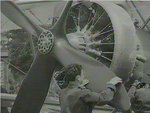swampyankee
Chief Master Sergeant
- 4,168
- Jun 25, 2013
a three blade prop has a higher efficency but the diameter of the prop to accept the greater HP would exceed the length of the landing gear so the only way around was to add more prop blades. However, there are some sources that claim that a four blade is more efficent at high altitude.
Hope that helped
Umnh, no. Since I did prop aero for a number of years, I know that the statement "three blade prop has a higher efficency[sic]" is, at best, an oversimplification. Induced losses are reduced with a greater number of blades; the loss of efficiency with greater blade numbers will occur if individual blade chords are excessively large or if there is interference between blade roots; the latter does not tend to be problematic with as few as six blades, and not until speeds that are greater than the operational speeds of almost all ww2 aircraft (modern propellers, such as those on the A400M, have the spinners contoured to eliminate that problem This requires cfd tools that didn't exist 30 years ago and weren't possible 50 years ago). There is a constraint on minimum blade chord; this is usually that the blade operates with large regions of separated flow and with highly angular airflow in the propeller in some flight regimes, especially takeoff, and this dictates the thickness at the blade root, which will tend to dictate the minimum chord.

